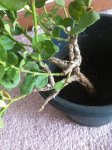Beleniel
Seedling
Hi, I'm completely new to bonsai, but I've been reading up on the internet about basic stuff and lurking around on this forum. For my first bonsai, I wanted an "indoor" tree. I ended up getting a natal plum (carissa grandiflora, I think), which is a tropical kind of tree. Unfortunately, I can't find much information on natal plum bonsai. Most of the stuff I find applies to landscaping, which I'm not sure how to apply to bonsai. So anything you guys can tell me (styling, care, etc.) would be incredibly helpful, since all I could find is just general bonsai information.
Some details about my tree:
Some details about my tree:
- It's currently sitting in potting soil. I know, not the best for bonsai, but I wanted to get it out of its pot since the roots were growing out the drain holes and drying out. It seems to be doing okay in the month it's been with me, but do I need to repot it into better soil right now?
- The leaves near the bottom and some smaller leaves have been turning yellow, red, then falling off. I read somewhere that it does that naturally, but I can't find anyone else who says that and I'm worried that I'm killing it. There is new growth that hasn't been yellowing, so maybe I'm too worried.
- I want it to be a smaller bonsai, so I'm hoping the thin trunk isn't as big an issue. I am a bit impatient to begin work on my tree, since it is my only one, lol. I figured it's okay to start thinking about styling and stuff since it's a tropical.
- I'm not sure if it will show up under my avatar, but I live in Coralville, Iowa. I have been keeping it outside on the balcony, but I will need to take it inside eventually for winter. Since I have no garage or anything like that, what kind of set up do I need? Grow lights?





